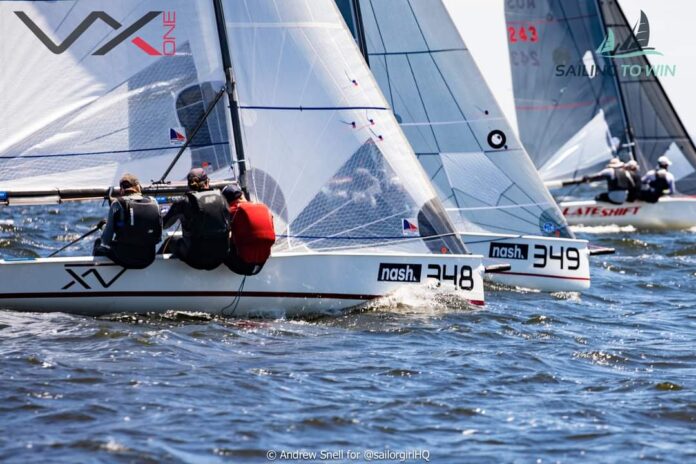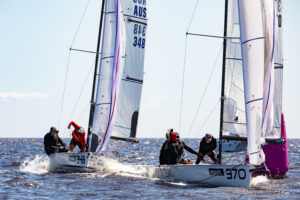

Sailboat racing consists of long periods of upwind or downwind sailing where you are concentrating on boat speed and tactics. These periods are punctuated by moments of intense action in the form of mark roundings.
Mark roundings are opportunities to make massive gains or consolidate gains you’ve already made.
Whether you are rounding a weather mark, leeward mark, or gybe mark, the main objective is to maintain your speed and momentum.
FREE CHAMPIONSHIP SAILING GLOVES
Rounding technique
Start by steering a smooth, gradual turn around the mark rather than an abrupt, tight turn.
Remember, the more you move the rudder off the centreline and the faster you do it, the more the boat will slow down. Too fast and the rudder actually acts as a brake.
With a weather mark rounding where you plan a bear away set, position your boat slightly above the layline so you can pass close to the far side of the mark as you turn downwind.
The advantage is that even if the crew has a problem getting the spinnaker up, you’ve maintained your boat speed and are still making progress down the track.
Maintaining your boat speed should apply around the gybe mark and leeward mark as well.
BOOK FOR YOUR SAILING BUDDY (and one for yourself)
Dealing with other boats
Sometimes boats around you will affect your rounding. If there’s any doubt about who has the right of way, or there is the possibility of a collision, be conservative.
Fouling another boat is always slow. it’s better to lose a boat than to have to do turns to exonerate yourself if you are in the wrong.
Nothing can improve your mark rounding more than concentrated practice. Practice sessions should see you going around upwind and downwind marks repeatedly.
Minimise Risk at Marks
Marks involve a high degree of risk because boats converge there, the fleet gets very compressed and the stakes are high.
Therefore, before you get to a mark think about how much risk are you willing to take. For example, would you be willing to try cutting inside the boats ahead if that meant a 50% chance of fouling?
What if it was 20%? The level of risk you should take at a mark (or anywhere else) depends on several factors including:
a) how far you are from the finish;
b) how you are doing in the race; and
c) how you are doing overall in the series.
For example, if you’re at the first mark of the first race in a series, you shouldn’t take a very big chance.
If it’s the last mark of the last race, and you need to pass three boats to finish on the podium, then the risk of cutting inside the boats ahead might well be worth taking.
A couple of pointers to bear in mind when you are about to round.
- Plan the upcoming mark rounding and think about what will be happening on that leg.
- Work out what angle you will be sailing after the rounding
- A smooth turn helps you maintain boat speed more than a rapid, abrupt turn.
- Observe the boats approaching the mark with you and work out who will be where and how you will deal with them.
- When you are in proximity with other boats you have to react quickly so make sure that the crew gives you good visibility and feedback.
- Ensure trim matches the situation so that you have the best speed out of the turn.

